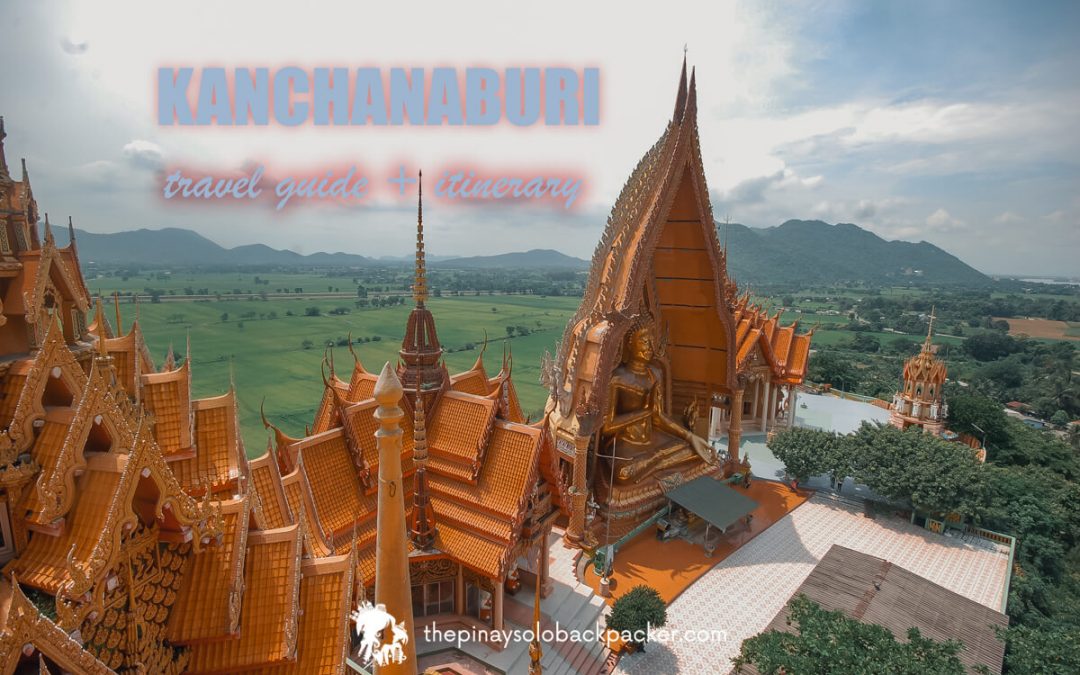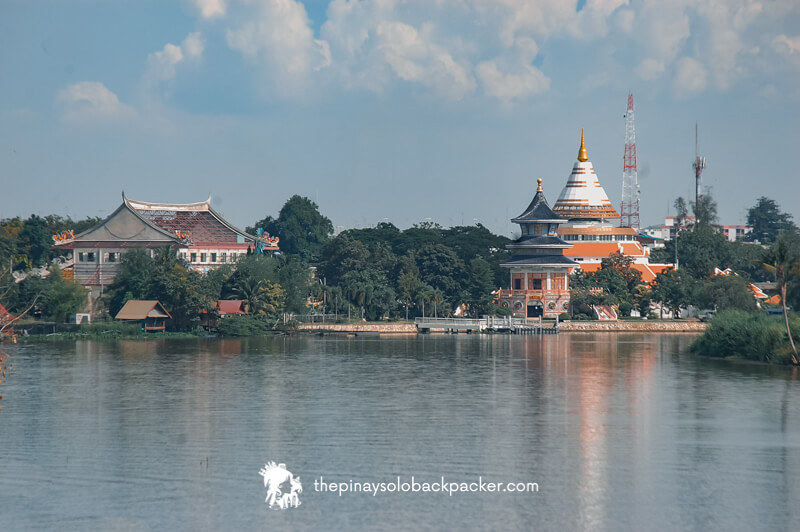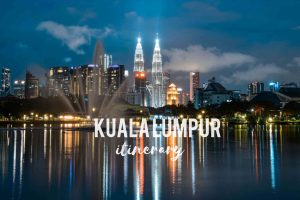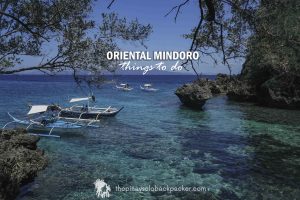Thing is, I seek history whenever I travel, it is pretty essential in helping me understand why the destination I am visiting is what it is today. It helps me understand how places and people change overtime, it teaches me about continuities, it encourages me to gain new insights, and more importantly, it helps me understand and appreciate the cultural values of a place. After all, the future is in the past.
Kanchanaburi is one of those places in Thailand that is steeped in history. It was founded by King Rama I as a stronghold for likely Burmese intrusions during the 18th century, and it was moved to its current location during the rule of King Rama III. Kanchanaburi has a pretty dark past and some of its traces are still evident today. It is best known for its World War II history and the key tourist spots associated with it, such as the Death Railway, the River Kwai Bridge (made famous by the movie River Kwai Bridge), and the Allied War Cemetery.
Though Kanchanaburi is well-known for its dark tourism sites, there are more places to see here for everyone, such as the sprawling Erawan National Park that is home to the seven-tiered Erawan Falls, the Instagram-worthy temples of Wat Tham Sua and Wat Than Kao Noi, the cave temple where Buddhist monks pray and congregate, the Elephants World, the retro city of Mallika that recreates the golden era of Siamese lifestyle during the reign of King Rama V, and the ancient Khmer temples at Mueang Singh Historical Park. It’s also a relief that Kanchanaburi has kept its relaxed atmosphere despite the crowd it brings. You can stay at a hotel by the River Kwai and enjoy the river that runs through magnificent scenery and funnel into the sea. Anyway, whatever you prefer to see and do, I hope this Kanchanaburi Travel Guide with detailed itinerary and sample budget helps you plan your much-awaited trip soon.
TRAVEL BLOG CONTENTS
KANCHANABURI PRE-TRAVEL GUIDE
BEST TIME TO VISIT KANCHANABURI
Kanchanaburi is a year-round tourist destination, but if you’re looking for the best months to visit, I’d recommend November, December, January, and February since the weather is cooler and the place has lesser crowd. Kanchanaburi is relatively humid especially during summer season which falls on March, April, and May, which is also the peak season. Prices of flights and hotels are higher during this season.
KANCHANABURI ATM AND MONEY EXCHANGE
Kanchanaburi like the rest of Thailand uses Thai Baht as currency. Some tourist establishments may accept US dollars, best to have Thai baht in handy. Almost everything is on cash basis, but major hotels and restaurants may accept credit card. The best rates are the bank’s rate. Best to withdraw from ATMs concentrated around the town center. You can find the ATM locations HERE.
KANCHANABURI WI-FI/INTERNET
Stay connected online while traveling in Kanchanaburi and the rest of Thailand. You can rent a pocket wi-fi or buy a sim card through the link below.
- KANCHANABURI POCKET WI-FI: RESERVE HERE
- KANCHANABURI SIMCARD: BUY HERE
HOW MANY DAYS TO SPEND IN KANCHANABURI?
Spending 2 or 3 days should cover the top tourist attractions in Kanchanaburi particularly the World War II destinations. But if you want to explore other note-worthy attractions, you could spend 4 days, 5 days, or 6 days in Kanchanaburi. Check-out my detailed Kanchanaburi itinerary below that is good for 3 days, 4 days, 5 days, and 6 days. Feel free to modify them depending on your budget, schedule, and preferences.
KANCHANABURI SAFETY
Kanchanaburi is pretty safe for tourists, even for solo female travelers. I traveled to Kanchanaburi alone and rented a bike to explore the main town. I never encountered any problems and the locals especially the monks I met inside the cave temple were super helpful and friendly.
KANCHANABURI TRAVEL GUIDE
HOW TO GET TO KANCHANABURI

BANGKOK TO KANCHANABURI BY TRAIN
Tourists can take the historic train route along the Bangkok Noi-Nam Tok rail line from Thonburi Station, Bangkok to Kanchanaburi train station or River Kwai Bridge. Travel time is roughly 2.5 – 3 hours and Kanchanaburi train fare is approximately ฿100 – ₱159 ($3, SGD 4.46, MYR 13, € 3, AUD 4.79, ₩K 3.8k). There are 2 scheduled train trips between Kanchanaburi from Thonburi Station (Bangkok) daily:
| TRAIN ROUTE | DEPARTURE | ARRIVAL |
| Bangkok to Kanchanaburi | 07:50 AM | 10:25 AM |
| Bangkok to Kanchanaburi | 10:42 AM | 12:35 AM |
| Kanchanaburi to Bangkok | 01:55 PM | 04:24 PM |
| Kanchanaburi to Bangkok | 04:32 PM | 06:30 PM |
*Schedule may change without prior notice.

BANGKOK TO KANCHANABURI BY BUS
There are buses that run to Kanchanaburi daily from either the South Bus Terminal (Sai Tai Mai) and the North Bus Terminal (Mo Chit) in Bangkok. Transit time to Kanchanaburi is roughly 2.5 hours and bus fare starts at ฿120 – ₱191 ($ 3.75, SGD 5, MYR 16, € 3.44 , AUD 6, ₩K 4.6k) per person. You can buy tickets at the bus station or book a ticket online in advance to secure a seat.
BUS TICKET: RESERVE HERE
BANGKOK TO KANCHANABURI BY MINIVAN
Alternatively, from Victory Monument in Bangkok or from Khao San Road, you can ride a minibus directly to Kanchanaburi. But fare is more expensive. Fare starts at ฿150 – ₱240 ($5, SGD 7, MYR 21, € 4, AUD 7, ₩K 5,833k) per person and it’ll take about 2.5 hours to reach Kanchanaburi. These minibus are usually run by local travel agencies.
BUS TICKET: RESERVE HERE
BANGKOK TO KANCHANABURI BY PRIVATE CAR OR VAN
If you are traveling in a group, a hassle-free way to visit Kanchanaburi from Bangkok is by private car or van, you can rent a car or van that is good for 3-10 persons and divide the rental cost. Best to book a reliable car rental company through the link below:
CAR RENTAL: BOOK HERE
TAXI RENTAL: BOOK HERE
GETTING AROUND KANCHANABURI
It’s quite easy to reach the major tourist spots in Kanchanaburi town, you can do that by bicycle, motorcycle, or tuktuk.

BY TOUR PACKAGE
A convenient and reliable way to tour Kanchanaburi is by joining group tours or booking a private tour. This will help you maximize your time and ensure that you have a tour guide to explain the details and history of each tourist attraction.
- KANCHANABURI INSTAGRAM TOUR (DAY TOUR FROM BANGKOK): RESERVE HERE
- KANCHANABURI HIGHLIGHTS (PRIVATE TOUR): RESERVE HERE
BY TUKTUK
Tuktuk short rides from the hotel in downtown Kanchanaburi to the River Kwai Bridge will cost roughly ฿40 – ₱64 ($ 1.25,SGD 1.78, MYR 5.46, € 1.15, AUD 1.91, ₩1,555) per person.
BY BIKE
You can explore the tourist attractions in Kanchanaburi town, however, the other tourist destinations listed below can only be reached by public transport or car/motorcycle rental.
Bike rentals in Kanchanaburi starts at ฿50 – ₱79 ($ 1.56, SGD 2.23, MYR 7, €1.44 , AUD 2.39, ₩K 1.9k per day. However, take note that Kanchanaburi is pretty humid, so make sure to use a cap/hat and keep yourself hydrated to avoid heat stroke. If you have a heart condition or you aren’t fit enough to cycle, do not force yourself to go biking to avoid untoward incidents.
BY MOTORBIKE
Kanchanaburi can be explored by motorcycle, but make sure you have an international driver’s license. Usually, motorcycle rental companies will also ask for your passport aside from driver’s license. Motorcycle can be rented for ฿200 – ₱79 ($ 1.56, SGD 2.23, MYR 7, €1.44 , AUD 2.39, ₩K 1.9k per day, gas not included.
BY CAR RENTAL
Touring Kanchanaburi by car is a convenient way to explore the province. This is recommended if you are traveling by group, just hire car for a day to reach the tourist spots outside Kanchanaburi center and share the cost. You can book a reliable car company through the link below.
CAR RENTAL: RESERVE HERE
WHERE TO STAY IN KANCHANABURI
When choosing a hotel in Kanchanaburi, tourists usually prefer these 2 locations: hotels in Kanchanaburi near the River Kwai Bridge, or hotels in Kanchanaburi town center.
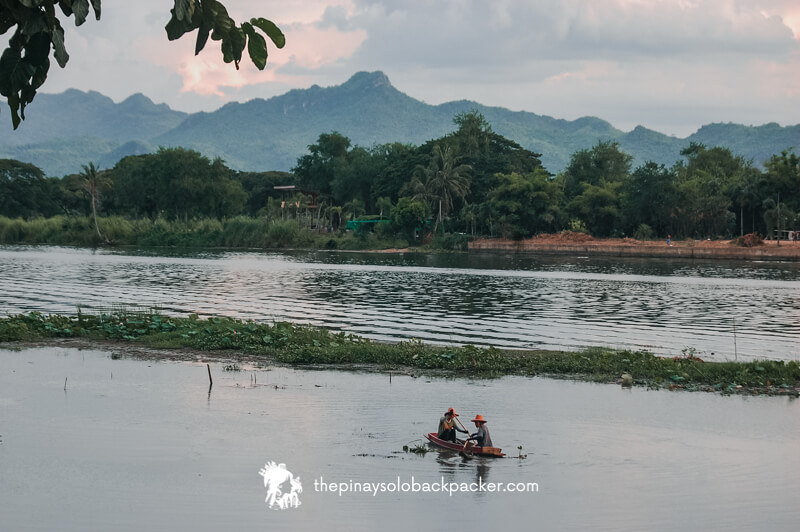
BAMBOO HOUSE KANCHANABURI
Location: River Kwai, Kanchanaburi
- SKY RESORT KANCHANABURI
Location: River Kwai, Kanchanaburi
- RIVER KWAI HOTEL
Location: River Kwai, Kanchanaburi
- RIVER KWAI BRIDGE RESORT
Location: River Kwai, Kanchanaburi
TOP TOURIST ATTRACTIONS IN KANCHANABURI
1.BRIDGE ON THE RIVER KWAI (DEATH RAILWAY BRIDGE)
The most popular tourist attraction in Kanchanaburi is the Death Railway Bridge or the Bridge on the River Kwai, which is featured in the Academy Award-winning movie “The Bridge on the River Kwai”. It is part of the Thai-Burma Railway built by coercing hundred thousand British, Dutch, Australians, and Americans soldier prisoners and Southeast Asian laborers to build the said rail. This was because, after already invading Thailand, the Japanese during the World War II also wanted to invade Burma (Myanmar). So, they planned to deliver weapons and soldiers to Burma via a railway connecting Thailand and Burma. The said construction led to hundred thousand death, and many of the prisoners of war (POW) are now buried at the Kanchanaburi War Cemetery.
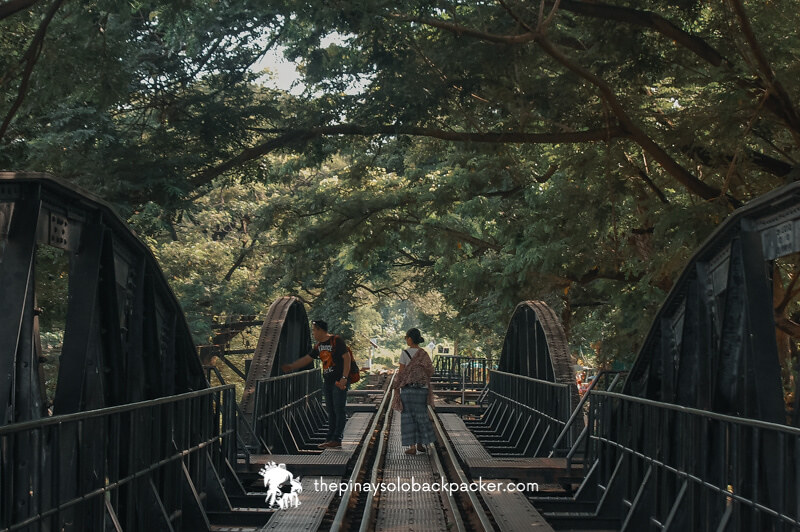
- Bridge on the River Kwai
- Entrance Fee: FREE
- Open Hours: 24/7
- How to get to the River Kwai Bridge: Hire a tuk-tuk from your hotel/guesthouse for about ฿40 – ₱64 ($ 1.25,SGD 1.78, MYR 5.46, € 1.15, AUD 1.91, ₩1,555) to take you to the Bridge on the River Kwai. Or rent a bicycle or motorbike from your guesthouse/hotel.
For a hassle-free tour, you may book a Kanchanaburi tour package:
- KANCHANBURI PRIVATE TOUR: RESERVE HERE
- KANCHANABURI INSTAGRAM TOUR (Day tour from Bangkok): RESERVE HERE
2.JEATHWAR MUSEUM

From the River Kwai Bridge you can walk to the JEATHWar Museum (Japan, England, Australia/USA, Thailand, and Holland War Museum), located in the grounds of a temple named Wat Chai Chumphon. The museum displays war relics, letters and artworks from POWs (Prisoners of War), their family members, including interviews of POWs. Interestingly, one gallery here was designed a bamboo shelter called attap where the prisoners of war lived during the war. Beside the JEATHWar Museum is a majestic Buddhist Temple that houses stunning wall paintings.

- JEATHWAR Museum
- Entrance Fee: ฿50 – ₱79 ($1.53, SGD 2, MYR 7, € 1.41, AUD 2.43, ₩1.8K)
- Open Hours: Daily 8:00 AM – 5:00 PM
- How to get to the JEATHWar Museum: You can rent a tuk-tuk for about ฿40 to take you to JEATH War Museum. Alternatively, you may also rent a bike or motorcycle from your guesthouse/hotel. If coming from the River Kwai Bridge, the museum is walkable
3.CHUI KAI WAR CEMETERY
Chui Kai War Cemetery is the exact site of the Allied prisoner-of-war camp during the World War II, located about 3 km south of the River Kwai Bridge at the bank of Kwai Noi River. During the World War II, prisoners even built their hospital and church nearby. This beautifully-manicured cemetery houses the graves of 1,400 Commonwealth soldiers and 300 Dutch soldiers. I cycled here during my trip to Kanchanaburi because it’s quite easy to reach from my guesthouse. The place though peaceful and full of greenery and flowers now, still evokes a disheartening atmosphere because of its tragic history.

- Chui Kai War Cemetery
- Entrance Fee: Free
- Open Hours: Daily 7:00 AM – 6:00 PM
- How to get to the Chui Kai War Cemetery: Rent a bicycle from your guesthouse/hotel and cycle to the Chui Kai War Cemetery. It is roughly 3 km south of the River Kwai Bridge. Alternatively, you may hire a tuk-tuk to take you there for about ฿40 – ₱64 ($ 1.25,SGD 1.78, MYR 5.46, € 1.15, AUD 1.91, ₩1,555).
4.KAOPOON CAVE TEMPLE

Kanchanaburi has some of the most stunning temples I’ve seen in Thailand, and interestingly, it is home to a handful of cave temples. I originally planned to visit Kaopoon Cave Temple that is said to have been visited by King Rama V (King Churalongorn the Great) via waterway. Today, several boats in Kanchanaburi near the River Kwai Bridge can be rented to get here. I cycled to this place from my hotel near the River Kwai, and unfortunately, I didn’t have enough information at that time of my visit. I thought upon entering the first cave temple, I was already at Kaopoon Cave Temple. Turns out, I only entered the Phra Mae Guan Im Pho Thi Sat Chao shrine, the first shrine with a large Buddha sitting on a summit of a hill overlooking a scenic river, which is pretty popular among locals, as they usually come here to pray. Despite not reaching Kapoon Caves, I enjoyed my visit at Phra Mae Guan Im Pho Thi Sat Chao because a helpful Buddhist monk toured me around the place. I met his other Buddhist friends as well and we had a quick chat and photo op. If your keen to reach the Kaopoon Caves, there’s a wagon for roughly THB50 per person that can take you farther to Kaopoon Cave Temple, about 2,000 meters farther.

5.ERAWAN NATIONAL PARK
Initially, Erawan National Park was the reason why I was drawn to Kanchanaburi, I wanted to see the famed tourist spot here – the 7-tiered Erawan Falls, located inside the confines of the Erawan National Park on Tenassirim Hills. Erawan Waterfalls boasts of 7 levels of falls, which thankfully, are quite manageable to reach. The 1st level of Erawan Falls called Hlai Khuen Rung, is usually jampacked with local tourists since this is the perfect spot for picnic. Visitors can have lunch or snack here as there are food stalls nearby. The 1st level waterfall in Erawan Falls has pleasing, sapphire-colored water that flows into the pool with little fishes that can nibble your feet’s dead skin like those found on fish spa. Wang Macha, the 2nd level of Erawan Waterfalls also has an arctic-colored water bucketing into natural pools and rock formations. This is a good place for swimming as the water here is refreshing and there are comfort rooms, shower rooms, and changing rooms. The 3rd level of Erawan Falls called Pha Namtok plummets into a huge natural pool surrounded by trees and plants. The 4th level of Erawan Falls called Oke Nang Peesu is another crowd-pleaser because of its natural waterpark, where visitors can slide and bathe. Buea Mai Long, the 5th level of Erawan Falls is another Instagram-worthy tourist spot in Kanchanaburi with teal-colored water pouring into travertine pools. The 6th level of Erawan Waterfalls called Dong Prucsa is worth visiting despite its distance from the other waterfalls in the area. It tumbles down colossal rock formations before plunging into the natural pool. Meanwhile, the Phu Pha Erawan is the 7th level of Erawan Waterfalls is shaped like “erawan” – the 3-tiered white elephant in the Hindu mythology.

- Erawan National Park
- Entrance Fee: Adult (foreigner) ฿300 – ₱487 ($10, SGD 13 , MYR 41, €9, AUD 14, ₩K 12K), child (foreigner) ฿200 – ₱324 ($6.45, SGD 9, MYR 28, €6, AUD 9.45, ₩8K), Adult (local) ฿100 – ₱159 ($3, SGD 4.46, MYR 13, € 3, AUD 4.79, ₩K 3.8k), Child (local) ฿50 – ₱79 ($ 1.56, SGD 2.23, MYR 7, €1.44 , AUD 2.39, ₩K 1.9k),
- Parking fee: Car ฿30 – ₱48 ($ 0.94, SGD 1.34 , MYR4 , € 0.86, AUD0.96 , ₩1,166), motorbike ฿20 – ₱32 ($0.63, SGD 0.89, MYR 2.73, € 0.57, AUD 0.96, ₩K 777)
- Open Hours: Daily, Park Gate 8:00 AM – 4:00 PM, waterfall 1- 3 8:30 AM – 5:00 PM, waterfall 4-7 8:30 AM – 4:00 PM
- How to get to the Erawan Waterfalls: From Kanchanaburi Bus Station hop on the bus to Erawan National Park that leaves every hour from 8:00 AM to 5:30 PM. Remember that the last bus from Erawan to Kanchanaburi leaves at 5:00 PM. Don’t miss it. Bus fare is around ฿40 – ₱64 ($ 1.25,SGD 1.78, MYR 5.46, € 1.15, AUD 1.91, ₩1,555) per person, one way. Transit time is roughly 1.5 hours.
6.WAT THAM SUA and WAT THAN KAO NOI
Kanchanaburi is sprinkled with jaw-dropping temples, and my personal favorites are Wat Tham Sua (Thai-styled temple) and Wat Than Kao Noi (Chinese-inspired temple) because of their intricate design and scenic surroundings. The temples are proudly standing on top of a limestone hill near the Mae Khlong River.

After entering the temple gates, I took an old-looking cable car going up the temple for ฿20 – ₱32 ($0.63, SGD 0.89, MYR 2.73, € 0.57, AUD 0.96, ₩K 777). You can also opt to climb for free the 157 steps stairs. The giant golden Buddha made of golden mosaics and surrounded by stupas greets the visitors here. The largest stupa here houses murals that are mostly about the war with Burma and the Buddha images in different postures. During my trip to Wat Tham Sua and Wat Than Kao Noi in Kanchanaburi, there was no crowd, except for some locals and monks sporting their orange robes happily taking photos at the temple.

Wat Tham Suea (also Wat Tham Sua) is said to be called Tiger Temple because there’s a cavern here where tigers used to live, but now, only a small tiger shrine can be seen inside the cave. Adjacent to Wat Tham Suea is the equally charming temple named What Than Kao Noi reminiscent of Chinese temples. Wat Than Kao Noi is a Buddhist temple flanked with intricate tiled Buddha images, bells, and Buddha statues. Climbing this temple offers the best view of Wat Tham Suea and the surrounding farmland.

- Wat Tham Sua and Wat Than Kao Noi
- Open Hours: Monday to Friday 8:30 AM – 4:30 PM, Saturday and Sunday 8:00 AM – 4:30 PM
- *Entrance Fee: FREE, cable car going up the temple is ฿20 – ₱32 ($0.63, SGD 0.89, MYR 2.73, € 0.57, AUD 0.96, ₩K 777)
- How to get to Wat Tham Sua: There are group tours in Kanchanaburi that includes a visit to Wat Tham Sua and Wat Than Kao Noi. Alternatively, if you want a DIY Travel here, from Kanchanaburi, you can take a bus to Ratchaburi. Alight at the bus stop fronting Tha Mueang Hospital. From there, you can hire a motor taxi to take you to Wat Tham Sua. Or you can hire a tuk-tuk to take you to Wat Tham Sua from downtown Kanchanaburi.
7.ELEPHANTS WORLD KANCHANABURI
From an estimated 100,000 elephants in Thailand in the 19th century, there are only about 3,000 domestic and 2,000 elephants in the wild now, according to Elephants World Kanchanburi. The elephants in Thailand were used to carry logs for the logging industry back in the days. But after a devastating flood in 1989, logging activity was totally banned by the government to prevent further deforestation. Since then, the elephant owners needed to find other ways to finance the food and upkeep of the elephant.
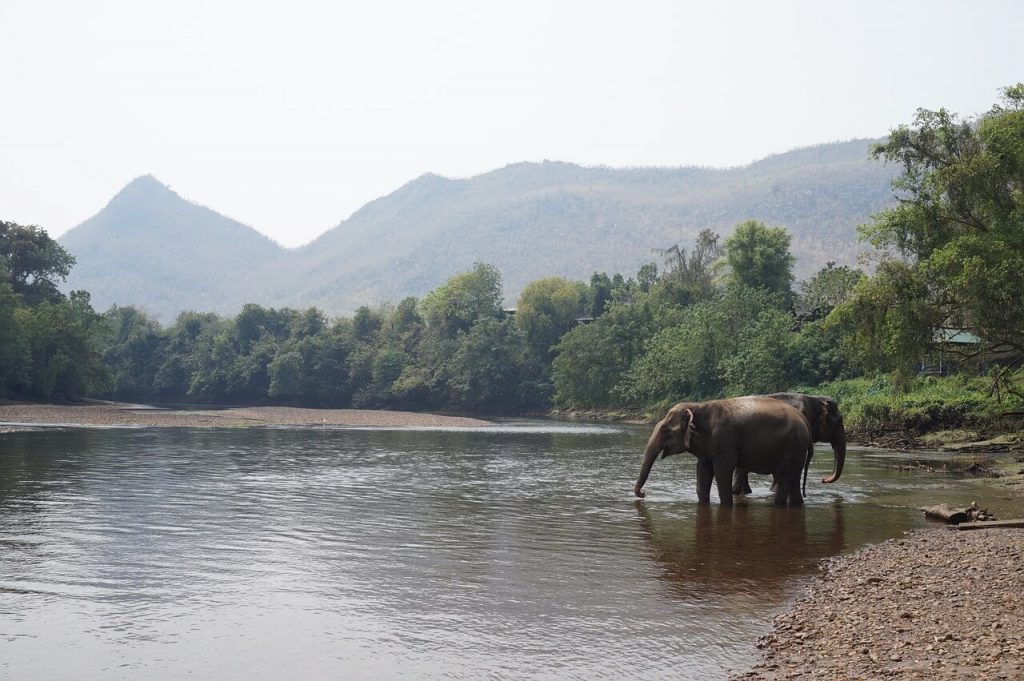
The Elephants World Kanchanaburi is a brainchild of veterinarian Dr.Samart and his wife Khun Fon. It started as a small home for the injured and elderly elephants in Kanchanaburi province. Later on, they started a fund-raising activity for the upkeep the said elephants and finally decided to switch the conservation program to an eco-tourism activity so they can self- finance the growing community of domestic elephants, mahouts, and staff. Nowadays, the Elephants World provides home to over 30 domestic elephants. They offer 3 kinds of programs – the Day Program, the Overnight Program, and the Forest Program so visitors can experience up-close and personal encounters with these elephants.
- ELEPHANTS WORLD KANCHANABURI (Day Program) : RESERVE HERE
8.MALLIKA KANCHANABURI
The massive Mallika City in Kanchanaburi is a retro-city of the former Siamese lifestyle in the Chao Phraya River basin. Mallika City remakes the Golden Age era in Thailand during the reign of King Chulalungkorn (Rama V) from 1873 to1910 A.D., best known for abolishing slavery in Thailand. At Mallika City, tourists can rent and wear Thai traditional clothes as they tour around, But first, every visitor has to change their Thai Baht to ancient money called Satang at the ticket office, which can be used to buy food, drinks and handmade local crafts at Mallika village.
Some of the most famous Mallika City tourist spots includes (1.)Saphan Han, the bridge that can be moved to allow boats to pass through and believed to be King Rama’s favorite bridge, the (2.) City Tower, originally a prison tower but now used as an observation deck of Mallika City, (3.) the Ancient Market Zone (Prange Nara, Prange Phuthorn, and Prange Sappasart neighborhood) where various ancients products are on display such as candles, perfumes, dessert, etc. and visitors are highly encouraged to participate in making these products (4.) Thai traditional houses and structures like Reuan Diew – the house for commoner, Reuan Khaha Bodi – the house for the rich and ruling class, Reun Pae Floating House – shophouse or café by the river banks, and Reuan Hmoo – used by the rich people as a visitor reception area, this is where tourists can watch Thai traditional dance and show during dinner, (5.) Jasmine Garden – a garden sprinkled with various kinds of jasmine plants, which inspired the named Mallika.
- Mallika Kanchanaburi
- Open Hours: 9:00 AM – 7:00 PM
- Entrance Fee:
| ADULT | CHILD | |
| Admission Fee | ฿250 – ₱397 | ฿100 – ₱158 |
| Admission Fee + Thai Costume | ฿400 – ₱635 | ฿300- ₱477 |
| Admission Fee + Lunch | ฿500 – ₱795 | ฿250 – ₱397 |
| Admission Fee + Thai Costume + Lunch | ฿650 – ₱1,033 | ฿450 – ₱715 |
| Admission Fee + Thai Dance Show + Dinner | ฿700 – ₱1,112 | ฿350 – ₱556 |
| Admission Fee + Thai Dance Show + Dinner + Thai Costume | ฿900 – ₱1,430 | ฿500 – ₱794 |
- MALLIKA KANCHANABURI TICKET: DISCOUNTED TICKET HERE
- How to get to Mallika City by public transport:To get to Mallika City by public bus, from Kanchanaburi Bus Station, a bus to Sangkhlaburi and tell the driver you are getting off at Mallika City. Fare is roughly ฿80 – ₱130 and travel time is about 3 hours. Buses run daily every 40 to 50 minutes from 07:00 AM to 5:00 PM.
9.PRASAT MUANG SINGH HISTORICAL PARK
When the Khmers abandoned Kanchanaburi, they left behind Several Bayon-style temples (similar to the temples in Cambodia) are sprinkled around the western side of Sai Yok District. These temples where abandoned by the Khmers who constructed the said structures during the rule of King Jayavarman during the Khmer Empire era. Some of these temples can now be visited by tourists traveling to Kanchanaburi at the stunning Mueang Singh Historical Park, surrounded by verdant forest and crowned by the main shrine – Prasat Muang Singh Temple, proudly standing at the heart of the domain. The ancient Buddhist temples at Mueang Singh are made of laterite, which explains their orange color. Apart from religious reasons, it is believed that these Buddhist temples were built to serve as a military post and transit of trade along the Mae Nam Khwae Noi. While you are at it, don’t miss the prehistoric burial site with pottery, jewelry, and 2 human skeletons on display, which is said to date back 2,000 years ago before Mueang Singh was founded.

Prasat Muang Singh Historical Park
Entrance Fee: ฿100 – ₱159 ($3, SGD 4.46, MYR 13, € 3, AUD 4.79, ₩K 3.8k)
Parking fee: Car ฿50 – ₱79 ($ 1.56, SGD 2.23, MYR 7, €1.44 , AUD 2.39, ₩K 1.9k), Motorcycle – ฿20 – ₱32 ($0.63, SGD 0.89, MYR 2.73, € 0.57, AUD 0.96, ₩K 777),
Open Hours: Daily 8:00 AM – 5:00 PM
How to get to the Muang Sing Historical Park: Take a train ( ordinary train #257 or #259) from Kanchanburi to Tha Kilen or Nam Tok Sa Yok Noi. Get off at Tha Kilen Station, travel time is about 1 hour. Then at Kilen Station, take a tuktuk to Mueang Singh Historical Park. The train departs around 10:35 AM and 4:26 PM. The train going back to Kanchanaburi leaves at 6:14 AM and 1:54 PM. Make sure not to miss the last trip going back to Kanchanaburi at 1:54 PM, be at the station at least 30 minutes before the scheduled departure. If you miss it, your next option is to take a taxi to Kanchanaburi. Foreigners are typically charged a higher fare of ฿100 – ₱159 ($3, SGD 4.46, MYR 13, € 3, AUD 4.79, ₩K 3.8k) per person one-way.
10.TREE TOP ADVENTURES
If you are the adventurous type, don’t fret because Kanchanaburi is home to Tree Top Adventures. This massive nature park is packed with 40 game stations where you can try extreme and exciting adventures!
TREE TOP ADVENTURE TICKET: DISCOUNTED HERE
DIY KANCHANABURI ITINERARY
Here’s a sample Kanchanaburi itinerary for 1, 2, 3, 4, 5, and 6 days. Feel free to tweak it depending on your budget, schedule, and preferences. Note that the transportation to and from Thailand from and to your country or next destination, accommodation, drinks, shopping, and souvenirs aren’t included in the sample expenses.

| DAY 1 | KANCHANABURI ARRIVAL + KANCHANBURI CITY TOUR |
| 08:30 PM | Bangkok to Kanchanaburi RESERVE HERE (฿250 – ₱406) |
| 12:00 PM | ETA Kanchanaburi |
| 12:15 PM | Tuktuk to hotel. (฿50 – ₱79) |
| 12:30 PM | Leave luggage at front desk. |
| 01:00 PM | Lunch (฿200 – ₱313) |
| 02:00 PM | Hotel check-in. Freshen up. |
| 03:00 PM | Bike rental. (฿50 – ₱79) |
| River Kwai Bridge. (FREE) | |
| JEATHWar Museum. (฿50 – ₱79) | |
| Buddhist Temple. (FREE) | |
| Chungkai War Cemetery. (FREE) | |
| 06:00 PM | Lunch. (฿200 – ₱313) |
| 07:30 PM | Back to hotel. |
| 08:30 PM | Lights out. |
| Day 1 Expenses | ฿750 – ₱1,269 ($24, SGD34, MYR 103, €21, AUD35, ₩ 29.2K ) |
| DAY 2 | ERAWAN FALLS |
| 07:30 AM | Tuktuk to Kanchanaburi Bus Station. (฿50 – ₱79) |
| 08:00 AM | Bus to Erawan National Park. (฿40 – ₱64) |
| 09:30 AM | Erawan National Park (฿300 – ₱487) |
| Explore Erawan Falls (Level 1-7) | |
| 11:30 AM | Lunch (฿200 – ₱313) |
| 12:30 PM | Bus back to Kanchanaburi (฿40 – ₱64) |
| 02:00 PM | Tuktuk to hotel. (฿50 – ₱79) |
| 02:30 PM | Freshen up. Rest. |
| 03:00 PM | Rent bike. (฿50 – ₱79) |
| 03:00 PM | Bike to Cave Temple |
| Cave Temple. (FREE) | |
| 05:00 PM | Bike back to hotel. |
| Freshen up. Rest | |
| 07:00 PM | Dinner (฿200 – ₱313) |
| 08:30 PM | Back to hotel. Pack luggage. |
| 09:30 PM | Lights out. |
| DAY 2 Expenses | ฿930- ₱1,478 ($30, SGD42, MYR 128, €27, AUD44, ₩ 36K ) |
| DAY 3 | KANCHANABURI TEMPLES |
| 08:30 AM | ETD Wat Tham Sua and Wat Than Kao Noi |
| Tuktuk to Kanchanaburi Bus Terminal (฿50 – ₱79) | |
| Bus to Ratchaburi (฿100 – ₱159) | |
| Get off at the bus stop in front of Tha Mueang Hospital | |
| Hire a motorbike to Wat Tham Sua and Wat Than Kao Noi. (฿100 – ₱159) | |
| Cable car. (฿20 – ₱32) | |
| Wat Tham Sua and Wat Than Kao Noi. (FREE) | |
| 11:00 PM | Motorbike back to Tha Mueang Hospital bus stop. (฿100 – ₱159) |
| Bus back to Kanchanburi (฿100 – ₱159) | |
| 12:00 PM | Tuktuk back to hotel. (฿50 – ₱79) |
| Hotel check-out. | |
| Tuktuk to Kanchanaburi bus Station. (฿50 – ₱79) | |
| Bus to Bangkok or next destination. RESERVE HERE (฿250 – ₱406) | |
| DAY 3 Expenses | ฿ 820 – ₱1,311 ($26, SGD37, MYR 113 , € 24, AUD38 , ₩32K) |
| TOTAL EXPENSES | ฿2,500 – ₱4,058 ($80, SGD 113, MYR 344, € 72, AUD 117, ₩97.2K) |
If you have more time and budget, you can extend your trip and spend 4 days, 5 days, or 6 days in Kanchanaburi using the sample itinerary below. Feel free to tweak it depending on your preferences.

| DAY 4 | ELEPHANT WORLD (1 DAY PROGRAM) |
| Elephant World Tour. RESERVE HERE (฿1,800 – ₱3,733) | |
| 09:00 AM | Hotel pick-up |
| 10:00 AM | Introduction and safety rules. |
| 10:30 AM | Meet and feed the elephants |
| 11:00 AM | Observe the elephants bathing |
| 11:30 AM | Prepare and cook fruits, vegetables, and sticky rice balls for elephants |
| 12:00 AM | Lunch |
| 01:00 PM | Observe the elephants enjoying mud bath |
| 01:20 PM | Plant banana trees and sugarcane (wet season) or prepare fruit basket |
| For elephants afternoon meal (dry season) | |
| 02:00 PM | Feed sticky rice ball for old elephants |
| 02:30 PM | Take part in elephant’s bathing activity |
| 03:20 PM | Feed fruits and vegetables to the elephants |
| 04:00 PM | Hotel drop-off. |
| 05:00 PM | Freshen up. Rest. |
| 07:00 PM | Dinner. (฿200 – ₱313) |
| 08:30 PM | Back to hotel. Lights out. |
| Day 4 Expenses | ฿ 2,000 – ₱4,046 ($280, SGD 121, MYR 371, € 77, AUD 127, ₩105.3K) |
| DAY 5 | MALLIKA CITY |
| 06:30 AM | Tuktuk to Kanchanaburi bus station. |
| 07:00 AM | Bus to Sangkhlaburi. (฿80 – ₱130) |
| 10:00 AM | Mallika City(Entrance, Costume, Lunch ( ฿650 – ₱1,033) |
| 12:00 AM | Lunch |
| 04:00 PM | Bus back to Kanchanaburi. (฿80 – ₱130) |
| 07:00 PM | ETA Kanchanaburi. Tuktuk to hotel. (฿50 – ₱79) |
| 07:30 PM | Dinner. (฿200 – ₱313) |
| 08:30 PM | Lights out. |
| Day 5 Expenses | ฿410 – ₱1,685 ($13, SGD 18, MYR 56, €12, AUD19, ₩ 16K) |
| DAY 6 | Prasat Muang Singh Historical Park |
| 09:30 AM | Hotel check-out. Leave luggage at front desk/concierge. |
| 10:00 AM | Tuktuk to Kanchanaburi Train Station. (฿50 – ₱79) |
| 10:30 AM | Train to Tha Kilen or Nam Tok Sa Yok Noi. (฿100 – ₱159) |
| 11:30 AM | Get off at Kilen Station |
| Tuktuk to Muang Singh Historical Park(฿50 – ₱79) | |
| 12:00 PM | Mueang Singh Historical Park. (฿100 – ₱159) |
| 01:30 PM | Tuktuk to Kilen Station (฿50 – ₱79) |
| 01:54 PM | Train back to Kanchanaburi |
| 03:00 PM | ETA Kanchanaburi. Tuktuk to hotel. (฿50 – ₱79) |
| 03:15 PM | Get luggage. |
| 03:30 PM | Tuktuk back to Kanchanaburi Bus Station. (฿50 – ₱79) |
| 04:00 PM | Bus to next destination. |
| Day 6 Expenses | ฿450 – ₱713 ($14, SGD20, MYR 62, €13, AUD 21, ₩ 17.5K) |

ALSO READ
TOP THINGS TO DO IN KANCHANABURI
SUKHOTHAI TRAVEL GUIDE
BANGKOK TRAVEL GUIDE
BANGKOK ITINERARIES

